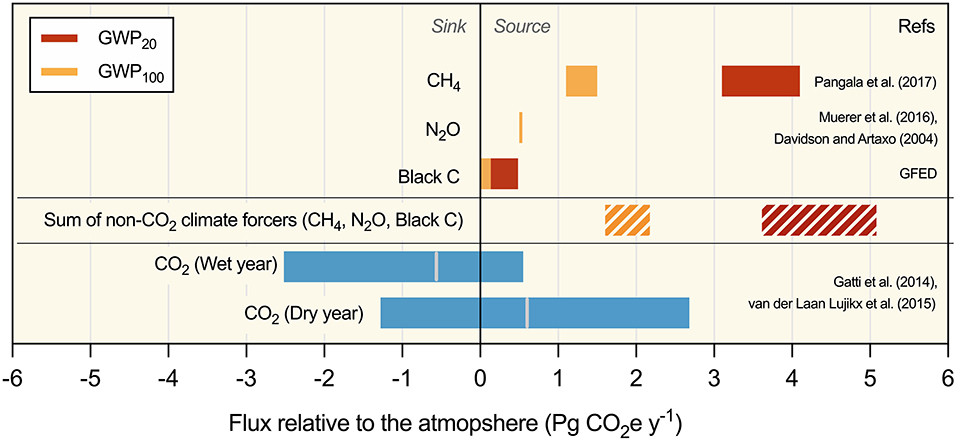Climate change and deforestation have transformed the ecosystem into a net source of planet-warming gases instead of a carbon sink.
The Amazon rainforest may now emit more greenhouse gases than the famously lush ecosystem absorbs, according to new research.
Long considered to be a bulwark against climate change because of its capacity to absorb carbon dioxide, a new study suggests rising temperatures, increasing drought and rampant deforestation have likely overwhelmed the Amazon’s ability to absorb more greenhouse gases than it emits, reports Craig Welch for National Geographic.
The sobering findings appear in a new study published earlier this month in the journal Frontiers in Forests and Global Change that calculates, for the first time, the net emissions of greenhouse gases from both human and natural sources in the Amazon Basin, reports Liz Kimbrough for Mongabay.
A key distinction in appreciating the study’s findings is that they do not just concern carbon dioxide, according to Mongabay. Though carbon dioxide often gets top billing in discussions around climate change, there are many other significant greenhouse gases, including methane, nitrous oxide, aerosols and sooty black carbon.
So, while the Amazon still absorbs and stores a prodigious amount of carbon, its net greenhouse gas emissions have tipped from negative to positive—not just because its capacity to absorb carbon dioxide has been damaged by human activity, but also because the transforming landscape has increased emissions of these other greenhouse gases.
“If you’re only looking at the carbon picture, you’re missing a big part of the story,” Kristofer Covey, an environmental scientist at Skidmore College and the study’s lead author, tells the New Republic’s Melody Schreiber. “We need to start understanding the full complexity of this ecosystem. We’re down there tinkering at a massive scale, and we don’t really understand the full implications of what we’re doing.”
For example, the dried-out wetlands and compacted soils that result from extensive logging often increase nitrous oxide emissions, and fires used to clear land for livestock and agriculture release particles of soot called black carbon that absorb sunlight and cause localized warming, according to National Geographic.
“Cutting the forest is interfering with its carbon uptake; that’s a problem,” Covey tells National Geographic. “When you start to look at these other factors alongside CO2, it gets really hard to see how the net effect isn’t that the Amazon as a whole is really warming global climate.”
Part of the issue is that many of the ways in which human activities are changing the Amazon end up being double or even triple whammies when it comes to greenhouse gas emissions. Say cattle ranchers burn a patch of rainforest to create new pasture for their herd, not only is the carbon dioxide absorbing power of the trees gone, but their stored carbon is released and the newly barren soil is likely to increase its emissions of greenhouse gases such as methane and nitrous oxide. What’s more, the grazing cows belch methane, a greenhouse gas roughly 30-times more damaging than carbon dioxide. Lost forest cover can also change patterns of rainfall and make the rest of the forest hotter and drier, which also tends to increase greenhouse gas emissions.
Overall, the pattern starts to sound like a worrisome feedback loop: deforestation increases greenhouse gas emissions which increases warming, and that warming then drives increased greenhouse gas emissions, and so on.
Though it may be a cold comfort, the study authors hasten to point out that as dire as their study’s findings sound, the entire enterprise of trying to calculate the Amazon’s net impact on global climate is incredibly complex.
“Parsing the complex interactions between the Amazon, its effects on climate, and human influences is a bit like trying to predict the stock market,” Fiona Soper, an ecologist at McGill University in Canada and co-author of the study, tells Mongabay. “t’s made up of moving parts: multiple climate forcers, not just carbon but also methane, nitrous oxide, particulates and biophysical effects, each being acted on by human stressors that range from dam building and hunting to climate change…Synthesizing these changes is a huge challenge.”
Speaking with National Geographic, Covey says it’s not too late to reverse the damage done to this natural treasure by ceasing deforestation and curbing the global use of fossil fuels.
But the time to take decisive actions necessary to restore the Amazon to its former glory may be limited. A 2018 analysis from a pair of leading researchers suggests the rainforest may be dangerously close to an ecological tipping point. If 20 to 25 percent of the Amazon is lost to deforestation that huge swaths of the rainforest may flip from rainforests to comparatively barren savanna, according to the 2018 study. To date, deforestation has claimed an estimated 17 percent of the Amazon.
Despite all this destruction, the Amazon’s stretches of intact rainforest remain essential and hugely beneficial to surrounding communities and the world, Soper tells Mongabay. “The main take away from this work,” she says, “should be a call to arms to prevent further degradation of the Amazon system.”
https://www.smithsonianmag.com/smart-news/amazon-rainforest-now-emits-more-greenhouse-gases-it-absorbs-180977347/


